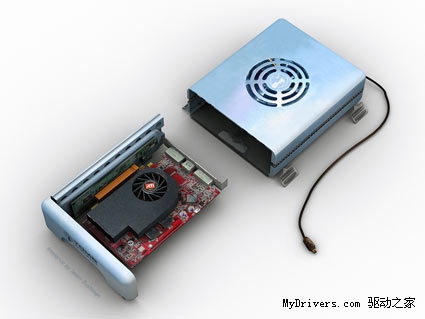 Rene Haas, general manager of NVIDIA's notebook division, revealed in a recent chat with a media reporter that an external discrete graphics card designed for notebooks is still being developed in-house.
Rene Haas, general manager of NVIDIA's notebook division, revealed in a recent chat with a media reporter that an external discrete graphics card designed for notebooks is still being developed in-house. In fact, notebook external video card is not a new concept, ASUS, MSI and many other manufacturers have tried, AMD has also launched the "XGP" technology, but for various reasons have failed to achieve real success, only an experimental nature.
Almost a full year ago, Rene Haas first confirmed that NVIDIA is developing external graphics cards for notebooks, but this time it did not announce more progress. It just said that NVIDIA is still working hard and everyone is waiting for good news.
Interestingly, Rene Haas mentioned the Thunderbolt interface during the conversation and seemed to consider it as an external video card connection scheme, but did not give a very clear statement. Sony's flagship notebook, the VAIO Z, released at the end of June this year provides a high-end external discrete graphics card Radeon HD 6550M with the Thunderbolt interface, so it is technically feasible.
Rene Haas also emphasized the success of his lead department, claiming that NVIDIA Mobile Graphics has won more than 200 notebook designs on the Intel Sandy Bridge platform.
An optical fiber cable is a cable containing one or more optical fibers that are used to carry light. The optical fiber elements are typically individually coated with plastic layers and contained in a protective tube suitable for the environment where the cable will be deployed. Different types of cable are used for different applications, for example long distance telecommunication, or providing a high-speed data connection between different parts of a building.
Optical fiber consists of a core and a cladding layer, selected for total internal reflection due to the difference in the refractive index between the two. In practical fibers, the cladding is usually coated with a layer of acrylate polymer or polyimide. This coating protects the fiber from damage but does not contribute to its optical waveguide properties. Individual coated fibers (or fibers formed into ribbons or bundles) then have a tough resin buffer layer and/or core tube(s) extruded around them to form the cable core. Several layers of protective sheathing, depending on the application, are added to form the cable. Rigid fiber assemblies sometimes put light-absorbing ("dark") glass between the fibers, to prevent light that leaks out of one fiber from entering another. This reduces cross-talk between the fibers, or reduces flare in fiber bundle imaging applications.
Butterfly Cable, Butterfly Patch Cable, Butterfly Drop Cable
Hebei Huanya Cable Co.,Ltd , http://www.hbhycable.com
